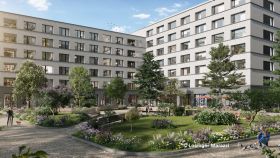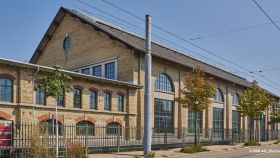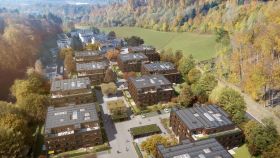

To exploit synergies, you need to plan the energy solution as a networked system from the beginning. One important aspect is the decentralised generation of electricity and the use and combination of local renewable energy sources for heating and cooling.
An energy management system records the energy flows of all consumers and producers and enables them to be optimally coordinated. This increases the flexibility and energy efficiency of the system while reducing costs.
Particular attention is paid to sector coupling, i.e. the intelligent networking of the heating, cooling and electricity supply, and mobility sectors. It makes it possible – including through storage and energy conversion technologies – to make better use of renewable energies and to draw as little energy as possible from outside.
ewz develops site-specific, integrated solutions for heating, cooling, electricity and mobility – both for existing buildings and for new buildings with different uses. If customers opt for an energy-as-a-service model, they can save both time and money while ensuring greater security of supply.

When planning integrated energy solutions, the following aspects need to be taken into account:
heat and cooling from local renewable sources
Thermal networks are a good way of supplying sites or complexes with CO2-free or neutral local heating and cooling. They can be implemented and operated on different scales and at different temperature levels:
- The energy for high-temperature networks largely comes from wood or the waste heat generated by waste incineration plants, while
- networks with low to medium temperature levels often use geothermal heat, lake and river water, ground water and waste heat (from computing centres, for example).
- The lowest operating temperatures are achieved by anergy networks or low-temperature networks, which also cool buildings in summer with the free cooling method.
To increase efficiency, different grid types and energy sources can be combined (see Côté Parc and Greencity).
Harness solar power with a high rate of self-consumption
To make increasing electrification as climate-friendly as possible, more electricity from renewable sources, such as solar power, is needed. It can be used on site for the operation of household appliances, lighting and heat pumps, as well as for cooling buildings.
A self-consumption association (ZEV) maximises the amount of energy consumed on site, which means that the photovoltaic installation is paid off quicker. What’s more, solar power is often cheaper than electricity from the public grid for ZEV participants. Local electricity communities (LEG), which are expected to be introduced in 2025 or 2026, enable solar power supply across properties and use the distribution grid.
Microgrids for security in planning and supply
Site electricity grids can be used to supply complexes, sites or neighbourhoods with electrical energy. Microgrids, or smart grids fitted with smart components, incorporate both generators and consumers of electricity. They help to ensure grid reliability by selectively switching on consumers, charging storage systems or throttling production. By making optimal use of locally available energy, microgrids also ensure stable prices over the long term and safeguard the value of a property or site.
Charging infrastructure and electromobility – the new standard
Electromobility is another important aspect of sustainable sites. To meet the growing demand for electric charging stations, it is a good idea to address construction of the charging infrastructure early on. Load management can help coordinate the electricity requirements of the charging station(s) with that of the other consumers in the building, and to regulate charging.
Storing energy for enhanced efficiency
With the share of renewable energies set to increase in the future, energy storage will become increasingly important. For example, electricity from renewable sources is produced irregularly depending on the weather, time of day and time of year. For example, electric car batteries configured for bidirectional charging can be used for storage purposes. Stationary battery storage systems are another means of absorbing surplus solar power and making it available again as required. Thermal storage units can be charged with solar power that would otherwise have to be fed into the public grid. This helps prevent peak loads, and also means that heat generators can set up in smaller dimensions. Geothermal probe fields can absorb excess heat (e.g. from solar panels or waste heat) to regenerate the ground and to cool spaces.
Reduce emissions and costs over the long term
Continuous energy monitoring is a good way to cut energy costs and reduce greenhouse gas emissions over the long term. Continuous monitoring of the electricity, heating and cooling consumption values in a property, for example, can serve as a basis for adjustment. Energy monitoring is also important for ESG reporting, which is already mandatory for certain companies. By constantly reviewing consumption data and ensuring professional operation, companies have an opportunity to reach their efficiency and environmental targets and to create transparency in their dealings with various stakeholder groups. Other advantages include a lower number of disruptions and a longer service life for the systems.






